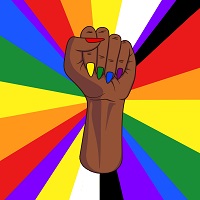Chilling Adventures of Sabrina has been acclaimed by popular critics for its portrayal of witches as sexually fluid and its development of multiple queer storylines. However, the series mostly revolves around a white cast; it only includes three recurring biracial characters in its first seasons– Ambrose (Chance Perdomo), Prudence (Tati Gabrielle) and Roz (Jaz Sinclair)–and adds Black voodoo priestess mambo Marie LeFleur (Skye Marshall) in its last two installments. Although queerness appears to be the norm in the witches' world, the diegesis still revolves around white cisgender characters in heterosexual relationships, thereby reasserting binaries of gender, race and sex. Our talk will focus on the intersection between the series' queer universe and the lukewarm, to say the least, reception of its treatment of blackness. We will strive to analyze the way the characters' Blackness, sexuality and wizardry intersect. We will also analyze the link between magic and identity.
In the first two seasons, the only member of the witch community to be shown in a non-heterosexual relationship is Sabrina's biracial bisexual cousin Ambrose. Estimated to be between 90 and 134 years-old yet still youthful-looking, the mixed-race British necromancer also happens to be the family's funeral home's mortician. Sabrina's cousin first appeared in the comic-book series in 1971, and Perdomo's embodiment of this character in CAOS is—to this day—the first to be both Black and pansexual. Ambrose is one of the few pansexual characters on TV today and one of the very few Black pan ones at that. His mixed racial identity, too, further contributes to the non-binary dimension of the character. Thus, does the show's portrayal of Ambrose's sexuality reflect widespread belief—among some popular critics and members of the audience—that pansexuality is but a whimsical extension of bisexuality? Does it treat pansexuality as a more contemporary version of bisexuality, one that would include non-binary possibilities? How, then, does the kind of magic wielded by Ambrose further fragment his identity? Finally, how is the portrayal of black queerness affected by the narrative irruption of voodoo priestess Marie LeFleur in season 3?

 PDF version
PDF version
